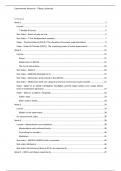Samenvatting
Summary Experimental Research - lectures, stat video's & papers (2023)
- Instelling
- Tilburg University (UVT)
Samenvatting van alle tentamenstof voor Experimental Research. Bevat aantekeningen vanuit de lectures, informatie van stat videos, en samenvattingen van alle papers.
[Meer zien]




